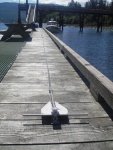Let's look at loads in three possible directions. (I'm an engineer, I think like this.)
One would be an axial load, in line with the chain length. This would be the tensile load the swivel is rated for and if it's a quality swivel, sized correctly, it should be fine.
The second possible direction is a twisting load, and if the swivel actually swivels, this load is very small, resulting from friction only, and not a problem.
The third direction is where you can have a surprise problem. It's possible to get one end of the swivel jammed against part of the anchor (or something else) so that it can't pivot to stay in line with the pull of the chain. This isn't the "swivel" direction that allows for chain twist; this is a "sideways" direction that tries to bend the axle inside the swivel, instead of rotating around its axis. The swivel is probably weakest in this direction and can be made to fail easily.
If the swivel is installed in between chain links somewhere it should be impossible to jam it in this problem position. The potential problem shows up when you have the swivel mounted directly to the anchor's shank and the mounting allows for the possibility of the chain being able to pull sideways against the swivel while the swivel gets "stuck" in the mount so it can't swing around to stay in line with the chain. If you have this kind of an installation, you've got a time bomb waiting to go off some time. Snap.
If your installation assures that the swivel can't be side loaded and you've bought a quality swivel and locked the pin so it can't come loose then all should be safe.
The problem I found on my 22 is that there's very little room between the windlass and the hoisted anchor. I don't think I can mount a swivel in there in a fashion that would guarantee no possibility of side loading, so I'm not using a swivel. If I put it farther along the chain, it wouldn't go through the windlass.
Regarding general swivel design, if the ends of the swivel were big loops, like chain links, this bending issue probably couldn't come up. (You'd have a challenge to attach the chain or anchor, though.) When the ends of the swivel are parallel arms with a pin going through, then the flat side of the parallel arms can be made to jam against the flat sides of the anchor shank and you can have the bending problem.
Diagrams would help a lot, but I think I've covered it all in text here. There are other possible complications, too, like a compound bending and tensile load resulting from trying to load the swivel sidways and having part of the swivel act as a lever to add a tensile load to the bending load on the axle.
I think the main concern, though, is making sure you can't have the side loading condition (third direction discussed above) as a result of your installation geometry. Then you should be safe.
Jeff

